One of A Kind - The Giraffe
The Giraffe - An Example of a Monotypic Genus
The giraffe (Giraffa camelopardalis) belongs to the family, Giraffidae, and the genus Giraffa. 'Camelopard' is an archaic English name for the giraffe referring to its camel-like face and leopard-like patches.
Giraffa is a monotypic genus as there is only one species belonging to it. The only other genus in Giraffidae is Okapia of which the okapi is the sole representative. There are many animals which are the sole representatives of their genera such as the black rhino, numbat, moose and African painted dog.
The giraffe is an ungulate (hooved) mammal, the tallest of all land-living animals and the largest of the ruminants.
Subspecies
Different authorities recognise varying numbers of subspecies, which are usually differentiated by size, pattern variations, colour and range.
Subspecies commonly recognised are:
G.c.camelopardalis is the nominate subspecies also known as the Nubian. The coat pattern has large, four-sided chestnut-brown spots on an off-white background. There are no spots below the hocks or on the inner legs. It is endemic to eastern Sudan and north-eastern DR Congo.

G.c.reticulata, known as the reticulated or Somali giraffe, has well defined, (usually) bright orange-brown patches with sharp edges and separated by bold, bright white lines. It is found in north-eastern Kenya, Somalia and southern Ethiopia. It seems to be the most common species found in zoos.
G.c.angolensis, known as the Angolan or smoky giraffe, has large spots with notches round the edges. The entire lower leg is patched. It is endemic to western Zimbabwe, Botswana, south-western Zambia, northern Namibia and southern Angola.
G.c.antiquorum, known as the Kordofan giraffe, has smallish, irregular spots. It is found in southern Chad, Central African Republic and northern Cameroon.
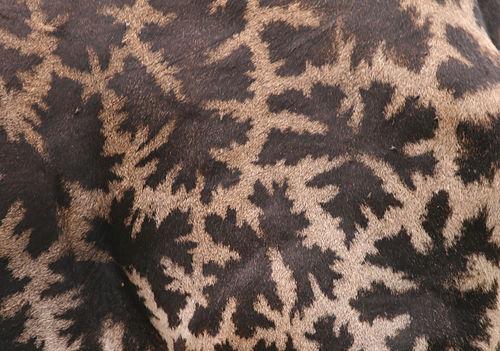
G.c.tippelskirchi, known as the Masai or Kilimanjaro giraffe, is the darkest coloured of the subspecies and is found in central and southern Kenya and Tanzania. The dark brown patches are the shape of vine-leaves with jagged edges on a brownish-cream background.
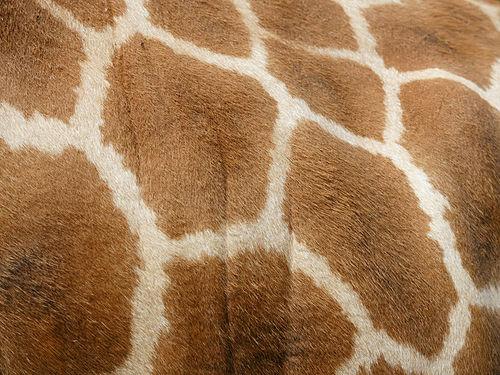
G.c.rothschildi, also known as Rothschild, Baringo or Ugandan giraffe, ranges from Uganda and west central Kenya and southern Sudan. It is often seen at Lake Baringo hence the 'Baringo giraffe' name. The patches are deep brown blotches or rectangular spots with poorly defined edges and cream background. There is little patterning on the very pale legs.
G.c.giraffa, or South African giraffe, has rounded or blotched patches. There may be star-like extensions on a light tan background. Patterning runs right to the hooves. It is endemic to northern South Africa, southern Botswana, southern Zimbabwe and south-west Mozambique.

G.c.thornicrofti, known as the Thornicroft or Rhodesian giraffe, has patches that are star- or leaf-shaped and extend down the legs. It is found in the Luangwa Valley in eastern Zambia.
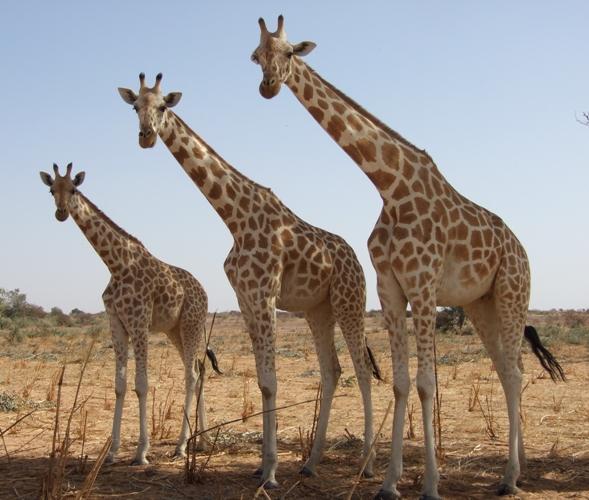
G.c.peralta, known as the West African or Nigerian giraffe, has a number of pale, yellowish red patches. It is endemic to southern Niger and is the rarest of the subspecies.
Some of these populations number in the hundreds and are in need of immediate protection. It is important for conservationists to appreciate that there are a number of subspecies and not just a generic giraffe.
Habitat
Savannas, grasslands and open woodlands are preferred by giraffe. If food is scarce they will move into areas of more dense vegetation. Acacias often form their main food source.
Description
The adult male giraffe may weigh from 800 to 1,200 kg and reach up to 5.5 metres at the tips of the horns. The tallest recorded was almost 6 metres. The females are smaller ranging from 550 to 830 kg and around 4 and 4.5 metres tall.
Even between animals of the same subspecies, each coat pattern is unique to each individual. The patches are the site of large blood vessels and large sweat glands and are thought to act as thermal regulators. The coat may serve as a chemical defence as it contains antibiotics and parasite repellents. At least eleven aromatic chemicals are present in the coat with old males having a very smelly odour.
Adults have a 12 cm long mane. The skull contains large sinuses in the upper part which lightens the weight of the head.
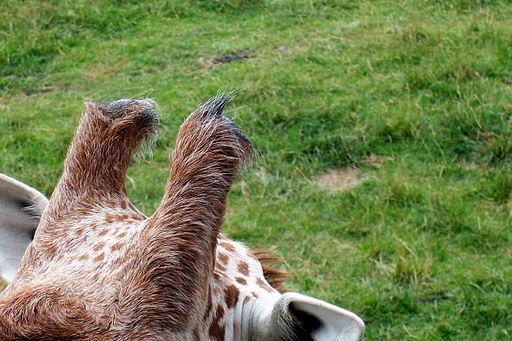
Both sexes have prominent horns called ossicones. The horns of the females usually have tufts of hair on top of the horns whereas the horns of the males are larger and generally have no tufts. Males sometimes appear to have several more than two horns but these are calcium deposits.
The neck of the giraffe is very elongated and may be over 2 metres in length. This can account for half its height. A shoulder hump of muscles supports the neck and allows the neck to spring back to into position after being lowered towards the earth. The giraffe has an equal number of vertebrae to most other deer and ungulate species. However the cervical vertebrae are disproportionately longer and comprise 45 to 50% of the length of the spine compared to the typical 30% of large ungulates. Much of this elongation occurs after birth.
The windpipe, because of its length, contains a mix of inhaled and exhaled air making oxygen levels low. This means the giraffe must take over 20 breaths a minute even in a resting state.

The Kingdon Pocket Guide to African Mammals (Princeton Pocket Guides)
Amazon Price: $24.95 $15.25 Buy Now
(price as of Apr 5, 2013) This essential guide covers every
species of terrestrial African mammal,
is fully illustrated and has
distribution maps.
The long neck has resulted in the evolution of a modified circulatory system. The heart weighs up to 10 kg and may be 60cm long. It needs to generate about double the normal blood pressure of a large mammal if it is to maintain blood flow to the brain. When the giraffe lowers its head to drink, complex processes in the upper neck prevent excess blood flow to the brain. The jugular veins also have valves which minimise blood flow to the head.
At the other end of the animal, the blood vessels of the lower legs are under great pressure because of the gravitational weight of fluids. High extravascular pressure is maintained by a very tight sheath of thick skin over the lower legs.
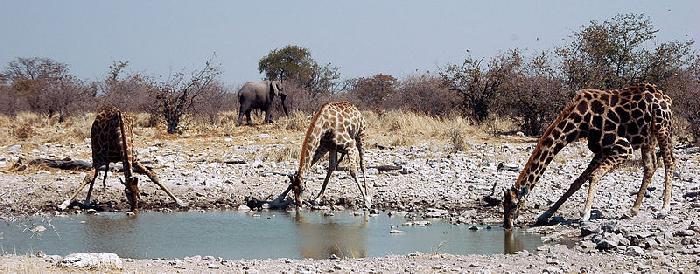
Locomotion
The forelegs of the giraffe are roughly 10% longer than the hindlegs. The hooves are divided into two toes and measure about 6 inches across in males and 4 inches in females. Giraffes can sprint at 60 km/h for short distances. It has a stiff gait when walking. The giraffe 'paces', moving both right legs together followed by both left legs. To gallop it moves the weight back onto the hindquarters and thrusts the front legs forward, pushing off again as they touch the ground.
Behaviour
Giraffes form loose groups which come together and disband every few hours. Only calving groups stay together for extended periods. Calves and juveniles are rarely left alone. Giraffes do not need long periods of sleep averaging only around 4 to 5 hours per day. Giraffes make a variety of noises although they are not often vocal. They can also produce sounds which cannot be heard by the human ear.
Nutrition
Giraffes browse on twigs and leaves. The tongue, lips and palate are tough and sharp thorns are ingested without injury. Acacia trees form a large part of their diet although they also eat grass and fruit. The prehensile tongue is about 45 cm long. Leaves are grasped with the tongue and pulled into the mouth.
Just like other ruminants, once food is swallowed, it is regurgitated and chewed again several times before finally passing into the stomach. The giraffe can go without water for extended periods, often getting sufficient moisture from green leaves. Giraffes feed mostly between 2 and 4 metres above the ground.
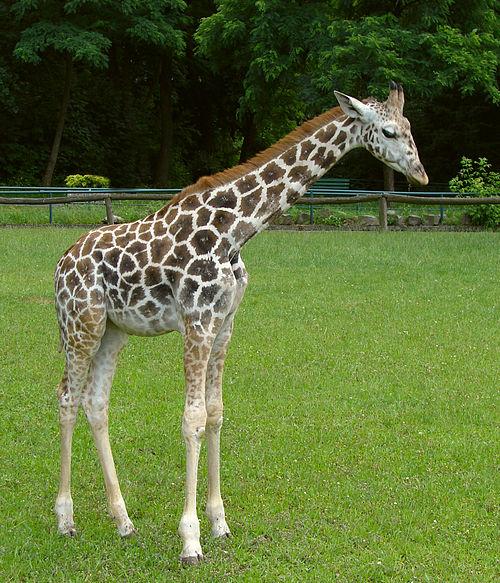
Reproduction
Giraffes have a gestation period of 400 to 460 days. Only older males are likely to be able to mate. Oestrous in females is detected by the male sniffing and/or tasting the urine of the female. Dominant males will stare down rivals and walk towards them, driving them off. Females will delay mating until the most dominant male is the only one around.
Generally a single calf is 'dropped' from a standing position with the birth sac bursting on hitting the ground. A newborn giraffe will be about 1.8 metres tall and weigh about 68 kg. Within a few hours, they are running but will spend a lot of time sleeping for a few weeks. Mothers with calves may move and browse together, even leaving their calves in a group with one female. If a calf is threatened, the female will stand over the calf and woe betide any animal that thinks a giraffe calf is easy prey.

The Safari Companion: A Guide to Watching African Mammals
Amazon Price: $30.00 $15.67 Buy Now
(price as of Apr 5, 2013) This new edition is indispensable for those
wishing to know more about the animals
they are likely to see on a visit to an African
wildlife park.
Giraffes are able to kick in all directions and can inflict great, if not lethal, damage. Their main predators are lions, wild dogs, spotted hyenas, leopards and crocodiles. Giraffes are at their most vulnerable when drinking as their vision is impeded and with their legs splayed or knees bent, they are not at their most balanced. Giraffes often travel with herds of zebra and wildebeest and with their excellent vision and height above the grasslands, they make great sentinels for the other species.
Only a quarter to half of all calves will survive to become adults. The lifespan is about 25 years in the wild and a little longer in captivity.
Males fight by 'necking', swinging their heads and necks against each other. These fights last only a few minutes and there is rarely any physical injury. It is common practice for males to court and caress other males by 'necking' in a sexual display which leads to mounting and climaxing.
Threats
Giraffes are hunted for the tails, hides and meat. The tails may become good luck charms or flyswats. The giraffe is a protected species with several of the subspecies being at great danger of becoming extinct. Although generally listed as 'of least concern', this is an overall view. It has vanished from many of its original habitats.
The West African giraffe has only one viable population of some 200 odd individuals still in existence. It is very difficult for conservationists to obtain accurate data but the West African, Nubian and Rothschild have been classified as endangered.
- Bizarre Sleeping Habits Of Animals
Bizarre Sleeping Habits of Animals Here are some animals with the most unusual behavior of sleeping. Humans need at least 8-hours of sleep to be able to rest and have sufficient strength for the next day. Over sleep or under...
- Interesting Facts About The Gigantic Giraffe
Giraffes are among the most fascinating animals on the planet due to their very tall appearance and unique markings which make them among the most well-known animals in the world.Here’s a long list of interesting and amazing facts about one of the...
- Beautifully Unique Mammals With Stripes
The two most popular striped mammals are the Tigers and Zebras. Aside from these two striped animals, can you name more stripes mammals? Western Bongo Image Source Western Bongo or Tragelaphus eurycerus eurycerus is unique mammal with white-yellow...
- One Of A Kind - The African Painted Dog
The African Painted Dog - An Example of a Monotypic SpeciesWhere Do African Wild Dogs Live?African hunting dog factsThe African painted dog is the only living species of the genus Lycaon although there are five recognised subspecies. It is therefore a...
- One Of A Kind - The Dhole
Monotypic Species - The DholeThe dhole (Asiatic Wild Dog, Red Dog) is another of those species which is the only representative in a particular genus. In the case of the dhole, the genus is Cuon. The dhole (Cuon alpinus) is a species of dog which is endemic...
